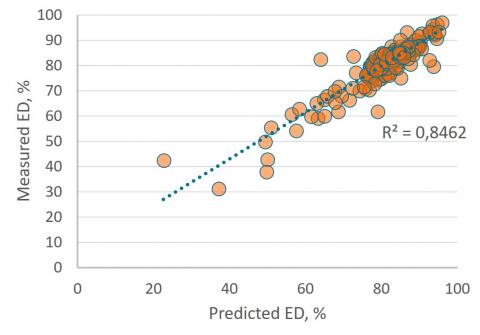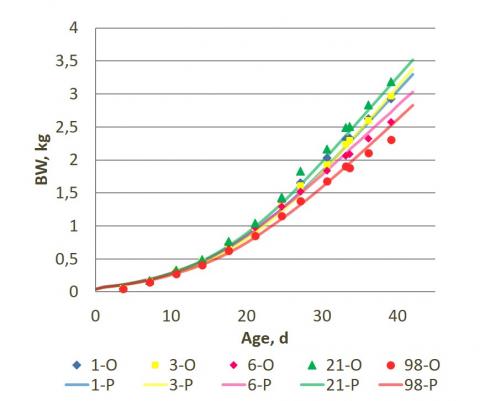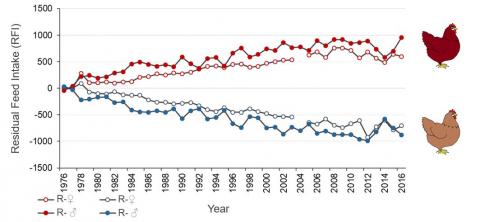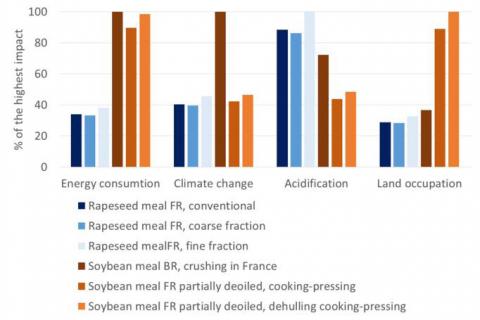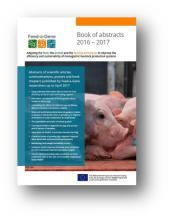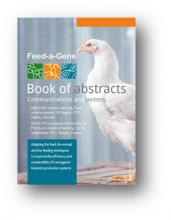Progress reports for the Feed-a-Gene project 2017-2018
Alternative feed ingredients and real-time characterisation (WP1)
WP leader: Knud Erik Bach Knudesn (Aarhus University) knuderik.bachknudsen@anis.au.dkNovel feed-processing from rapeseed and European-grown soybeans
- European-grown soybean meals (SBM) have been successfully processed by dehulling (or not), extrusion or flaking+cooking (FCP). They were analysed for chemical and antinutritional compounds and tested with piglets and broilers.
- The degree of hydrolysis was higher in the SBMs than in intact soybeans. The rate of hydrolysis was higher for the meal from extrusion processing. Dehulling lowered the fibre content and increased the maximum degree of hydrolysis in meal from extrusion processing, but decreased the degree of hydrolysis in meal from flaking cooking. None of the processes caused lysine damage.
- In vitro laboratory tests were used to select proteases and NSPases for animal studies.
- A conventional European rapeseed meal (RSM) has been identified and upgraded at Hamlet Protein for studies with pigs.
Production of feed protein from green biomass
- 60% of the protein from green biomass extracted from grass and legumes was recovered in pulp and 40% in juice. Proteins in the juice were precipitated to produce a concentrate with 35-45% protein. There was no difference between acid and heat precipitation. Amino acid composition was similar to that of soybean. About 15% of the protein of the plant remained in the residue.
- Two large-scale fractionation experiments in a pilot plant were performed in 2016 and 2017 and used for pig trials. Enzyme addition during protein extraction did not improve the protein yield but modified the carbohydrate fraction.
Novel feed-processing technology to upgrade alternative feed ingredients
- Large-scale RSM sifting and division into fine and coarse fractions have been carried out. The fine fraction had a higher protein content, while the amino acid composition did not vary between fractions.
- Samples of RSM from five different suppliers were divided in a lab-scale experiment into fine and coarse fractions. All fine fractions had lower crude fibre content
Nutritional evaluation of novel feed ingredients
- The green protein concentrates were included at a level of 30% in experimental pig diets without negative impact on feed intake. There was no difference between the sources in standardized ileal digestible (SID) amino acid content, except for methionine and alanine.
- The SID of crude protein was 22-33%-units lower than that of SBM and SID of amino acids was on average 15%-units lower (from -3 to 54).
- Pigs had significantly lower body weight and average daily gain, and higher feed conversion ratio when fed with the FCP dehulled SBM compared to control pigs. In line with performance data, amino acid digestibility was lower in the FCP dehulled SBM.
- In broilers, SBM processing did not affect any of the tested variables, and all 4 processes resulted in similar performance. Aside from increased carcass yield, hull removal did not confer a significant advantage, possibly due to the adaptive growth of the gizzard and proventriculus in the hulled treatments.
Improvements in nutritive value by use of novel enzymes
- Mechanical improvement of RSM increased its protein content, which improved feed efficiency due to a reduction of feed intake. No effect was observed on growth performance. No effect of enzyme inclusion on dry matter, energy or nitrogen digestibility was detected.
New methodologies for characterisation of nutrient composition and value
- Predictive calibration models were obtained on NIR scans for 328 cereal samples. Models for chemical data (including amino acids) and biological data from pig trials have been evaluated. In general, NIR calibration models had good predictive ability and robustness, though they were not suitable to predict the mineral composition of cereals.
- The removal of anti-nutritional components from RSM and the isolation of a fine fraction both enhanced protein content, but did not substantially affect amino acid pattern. No substantial effects on lysine damage were observed, and lysine damage varied between 0 and 5% of total lysine.
Energy digestibility of cereal grains in pigs: measured vs predicted by NIRS (Noel et al., 2018, Aarhus University)
Identification of feed efficiency traits related to individual diversity (WP2)
WP leader: Alfons Jansman (Wageningen University) alfons.jansman@wur.nlIndividual feed intake and feeding behaviour in broilers and rabbits
- The development of feeding stations to monitor feed intake and body weight of individual rabbits and broilers in group-housing systems was completed.
- Hardware and software were redesigned and modified to create devices, linked data collection software, and tools suitable for experiments carried out to evaluate the effects of dietary and other interventions on individual feed intake in group-housed broilers and rabbits.
New traits and technologies for measuring and improving digestive efficiency and gut health in pigs, poultry and rabbits
- New knowledge has been generated linking the composition of the intestinal and faecal microbiota to nutrient digestibility and systemic metabolic parameters in pigs, rabbits, and broilers.
- A new method using NIR technology to measure nutrient digestibility more easily in a large number of samples is being developed in pigs.
Nutrient metabolism-related traits to improve feed efficiency
- Absolute N retention at later age is affected by birth weight of pigs. However, relative N efficiency is not affected by birth weight.
- Analysis of the relationship between experimental treatments with metabolome profiles in blood is ongoing.
Behaviour and welfare-related traits influencing feed efficiency
- A methodology capable of the automatic measurement of a variety of traits at a group level related to feed intake behaviour in pigs has been developed.
- A new method was developed to assess interactions between pigs, that uses electronic feed recording information for estimating the ranking of animals within a group as an indicator for behaviour in relation to feed efficiency.
Metabolomics to identify new traits for improvement of feed efficiency
- The blood metabolome of pigs and rabbits was shown to be affected by dietary treatment and genotype.
- In growing-finishing pigs, blood biomarkers measured at an early stage have been identified as indicators of feed efficiency.
Modelling feed use mechanisms and animal response to nutrient supply and environmental challenges (WP3)
WP leader: Veronika Halas (Kaposvár University) veronika.halas@ke.huDigestive utilisation of feed and nutrients
- A mechanistic-dynamic model of transit and digestion for pigs has been developed and improved. Its accuracy was confirmed by a comparison between observed and predicted digestibility values.
- This model was transposed to broilers. Inputs are the amount of nutrients ingested (proteins, free amino acids, lipids, starch, sugars, fibre, Ca, P). Equations represent the transit, hydrolysis, fermentation, and absorption of nutrients. Outputs are ileal and faecal nutrient digestibilities. Parameter quantification has been performed but the model needs to be validated.
Observed body weight (kg, dots) and predicted body weight (line) from five different datasets of Cobb broilers (Dukhta et al., 2018, Kaposvár University)
Metabolic utilisation of feed and nutrients
- The initial version of the post-digestive pig model has been improved with a better amino acid and protein model, and by adding models predicting P utilization, P retention and feed intake.
- The pig model was transposed to broilers. The broiler model is able to simulate the partitioning of energy and protein and predict P retention and excretion.
- A module estimates the body fatty acid composition of pigs and lipid distribution in the different tissues.
Accounting for environmental variability, system disturbance and robustness
- Work has been done on the ability to detect perturbations automatically, using the deviation of cumulative feed intake from a targeted trajectory as a response criterion.
- In pigs, a mechanistic model was developed to describe the adaptative response to a generic perturbation.
- In broilers, Bayesian inference methods were used to estimate perturbations in the performance of birds undergoing intestinal parasitic infection. Results suggest evidence for compensatory growth.
Accounting for variation among individuals in nutrient utilization and growth performance
- A Bayesian inference approach was used in pigs, broilers, and rabbits to obtain posterior distributions of parameters and traits reflecting within-individual variation and data uncertainty, and among-individual variation.
- The traits were growth rate, dynamic body composition, metabolic heat production, and energy and protein utilisation efficiency. Except for growth rate, individual traits were estimated through growth models and fitting serial trait observations.
- Trait estimates measure real-time individual performance; population trait distributions inform performance of breeds or treatments; individual-trait scatter plots identify phenotypic clusters.
- Metabolic heat production estimates agreed with literature data. Age-varying protein efficiency of pigs was within literature bounds.
Delivery of a Decision Support System (DSS)
- A first version of the decision support tool (DSS) was developed. Based on the InraPorc model for growing pigs, it includes a model for energy and protein metabolism, a module for P utilisation, and a spring and damper system used for characterizing the animal’s response to perturbation.
- In addition to model development, software development includes creating an interactive interface, language localisation and linear multivariable optimization. An open source version of the core model as well as a standalone desktop version for end-users are being developed. The first version of the DSS was shown at the stakeholder meeting held during the 2017 EAAP Annual meeting.
Management systems for precision feeding to increase resilience to fluctuating environments (WP4)
WP leader: Jesus Pomar (Universitat de Lleida) pomar@eagrof.udl.esDecision Support System development for real-time determination of animal nutritional requirements
- For growing pigs and broilers, a first version of the decision support system (DSS) was implemented using an architecture combining modules for analysing and predicting performance and for estimating the nutritional requirements of animals in real time.
- For gestating sows, an Excel procedure was created to implement the DSS.
- Simulations indicated that compared to classical feeding, precision feeding can reduce protein and amino acid intake and N excretion by 25% in gestating sows and lysine and protein intake by 6.2% in lactating sows.
- For broilers, a model implementation is now able to predict daily requirements for metabolizable energy, digestible lysine, and available P.
Requirements variability between sows, across the lactating period (Gauthier et al., 2018, INRA)
Controlling module (software and hardware) development to support feeder control tasks, real-time measurements
- The Controlling Module (CM) integrates all devices and software components involved in precision feeding systems. The CM acts as an intelligent multiple device and DSS integrator, with the capacity to control multitask processes such as monitoring, supervision, and data management.
- A language (ACL) was developed to establish the communication between the devices and the CM.
Precision feeder device development
- Enhanced precision feeder prototypes for growing pigs fed ad libitum or restrictively fed are now ready for validation.
- For group-housed gestating sows, a precision feeder device has been developed and is now installed in the experimental station of IFIP.
- An experimental accelerometer fixed to the sow’s ear is available to measure energy expenditure due to physical activity.
- For poultry, a complete design of precision feeding system is available.
Building and validation of precision feeding system prototypes
- Individual precision feeding of ad libitum-fed growing pigs significantly improved feed conversion and lean meat content of the carcass when compared to two-phase feeding. The total lysine intake tended to be reduced, but to a lower extent than expected.
- In restricted feeding conditions, feed efficiency and growth rate were similar for pigs fed a two-phase strategy or with precision feeding, but the latter strategy resulted in a 5% reduction in lysine intake.
- The validation tests of ACL communication between feeder devices and CM showed that the communication worked satisfactorily, and that the system reacts in a robust way when working under non-optimal conditions.
Use of new traits in animal selection (WP5)
WP leader: Hélène Gilbert (INRA) helene.gilbert@inra.frGenetics of components of feed efficiency and robustness indicators
- New traits on behaviour, welfare, and metabolomics indicators have been collected recently and no results are available yet.
- In pigs and layers, no deleterious relationships were shown between feed efficiency and responses to challenges, when comparing performance with different feeds in divergent lines.
- In broilers, 116 genomic regions were associated with 16 traits related to digestive efficiency, growth, and faeces composition.
- Only preliminary results are available on reproductive females. In sows, a genetic component of feed intake was found during lactation. In mice, there was a better robustness to stress conditions (restricted feed) for females selected for homogeneity of litter birth weights.
Residual feed intake in 2 feed-efficiency diverging lines of laying hens (Jehl et al., 2018, INRA)
Genetic relationships between gut microbiota and feed efficiency
- Selection on feed efficiency was successful for direct effects, but maternal effects were degraded by the selection (about 1/6 of the direct genetic gain).
- Feed, sex, line of feed efficiency, cross fostering, and feeding regimes had significant effects on gut microbiota composition in the different studies.
- Some microbiota phyla in rabbits were heritable.
- First association studies conducted on the average daily gain of rabbits fed restricted and ad libitum feeding showed four QTL regions on chromosomes 3, 5, and 21.
Statistical-genetic modelling of feed efficiency and robustness features
- Pen records of feeding levels can be used to improve genetic evaluation.
- Social genetic effects varied over time so it is important to account for them in selection.
- The structured antedependence model was validated and showed that the dynamics of feed efficiency over time is affected by selection.
- The joint estimations of genetic parameters for variability on multiple traits suggested the existence of a general robustness across traits.
- The alternative implementation of a genetic model with indirect genetic effects including feeding behaviour improved model performance.
Selection strategies to account for crossbred and genomic data for a sustainable selection for feed efficiency
- Accuracy and bias of predictions were used as primary criteria to evaluate the tested strategies. They indicated that the separation of additive and dominance components seems to be beneficial for some traits to evaluate purebred candidates to selection for crossbred performance.
- Including metafounders did not affect the accuracy and bias of predictions, but improved convergence of the model when the breeds were very distantly related to each other.
Demonstration of the value of social interactions and crossbred information in selection to improve feed efficiency
- Currently, approximately 40 million pigs have a breeding value for indirect genetic effects, including Topigs Norsvin animals tested in the different trials of the Feed-a-Gene project.
- In rabbits, a selection experiment is being carried out to obtain lines based on two selection criteria: average daily gain under restricted feeding (enhances competition) and residual feed intake with ad libitum feeding. Feed intake data from the first generation have been recorded in five batches of 130-150 rabbits each.
Sustainability assessment of production systems (WP6)
WP leader: Guy Garrod (University of Newcastle) guy.garrod@newcastle.ukIdentification of sustainability indicators for proposed production systems
- Stakeholders provided 102 usable responses to the Delphi survey. The highest-ranked dimension of sustainability was the Economic dimension, followed by Environmental and Social.
- Indicators related to financial viability of farming activities were the highest, reflecting that farming will not continue in the future if farms cannot achieve profitability.
Life Cycle Assessment
- The global feeding strategies to be evaluated through Life Cycle Assessment (LCA) have been set for pigs in conventional crossbred and South European Iberian pigs.
- A survey establishing the list of required data has been done among partners. Work on LCA for innovative production systems in poultry production has started.
Anticipated environmental impacts of new protein sources (Espagnol et al., 2018, IFIP, ITAVI)
On-farm evaluation of proposed management systems
- Variables required to handle Cost-Benefit Analysis have been set after literature analysis. Corresponding data are collected from farm specialised in pig and poultry production in Denmark, Germany, France, Poland and Spain over the 2010-2015 period.
Evaluation of consumer and farmer attitudes
- A literature review has been conducted on the use of choice experiments to explore public preferences and trade-offs for different livestock production attributes. This informed the design of a choice experiment questionnaire that will be used to estimate values for the most important externality attributes (e.g., environmental or animal welfare) associated with the management systems that are being examined.
Dissemination, training and technology transfer (WP7)
WP leader: Gilles Tran (AFZ) gilles.tran@zootechnie.frCommunication
2 intermediary newsletters have been sent since the 2nd newsletter:
Two booklets of abstracts have been distributed:
An animated Greeting card was sent to stakeholders in January 2018.
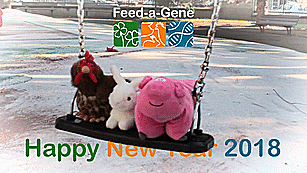
The 10 episodes of the Season 1 of Feed-a-Gene are now available on YouTube: watch researchers talk about Feed-a-Gene and their research on the project’s YouTube channel.
Better feeds, better animals: this video made for the general public is in the top 10 of the 300 videos created to showcase H2020 projects!
The stakeholder platform
- The stakeholder platform now contains 371 participants.
- A stakeholder session was organised during the EAAP meeting in Tallinn in August
Dissemination of results
Feed-a-Gene researchers participated in international and national events, particularly:
- EAAP 2017 (Estonia)
- EC-PLF 2017 (France)
- WCGALP 2018 (New-Zealand)
Feed-a-Gene researchers have published 9 peer-reviewed papers that are now available.
- Ragab M., Piles M., Quintanilla R., Sánchez J.P., 2018. Indirect genetic effect model using feeding behaviour traits to define the degree of interaction between mates: an implementation in pigs growth rate. Animal, 12 (7): 1-9 doi.org/10.1017/S1751731118001192
- Tallentire C.W., Mackenzie S.G., Kyriazakis, I., 2018. Can novel ingredients replace soybeans and reduce the environmental burdens of European livestock systems in the future? Journal of Cleaner Production, 187: 338-347 doi.org/10.1016/j.jclepro.2018.03.212
- Beauclercq S., Nadal-Desbarats L., Hennequet-Antier C., Gabriel I., Tesseraud S., Calenge F., Le Bihan-Duval E., Mignon-Grasteau S., 2018. Relationships between digestive efficiency and metabolomic profiles of serum and intestinal contents in chickens. Scientific Reports, 8: Article number: 6678 doi.org/10.1038/s41598-018-24978-9
- Verschuren L.M.G., Calus M.P.L., Jansman A.J.M., Bergsma R., Knol E.F., Gilbert H., Zemb O., 2018. Fecal microbial composition associated with variation in feed efficiency in pigs depends on diet and sex. Journal of Animal Science, 96 (4): 1405–1418 doi.org/10.1093/jas/sky060
- Sánchez J.P., Ragab M., Quintanilla R., Rothschild M.F., Piles M., 2017 Genetic parameters and expected responses to selection for components of feed efficiency in a Duroc pig line. Genetics Selection Evolution, 49:86 doi.org/10.1186/s12711-017-0362-x
- Huynh-Tran V.H., Gilbert H., David I., 2017. Genetic structured antedependence and random regression models applied to the longitudinal feed conversion ratio in growing Large White pigs. Journal of Animal Science, 95 (11) : 4752-4763 doi.org/10.2527/jas2017.1864
- Wientjes Y.C.J., Calus M.P.L., 2017. The purebred-crossbred correlation in pigs: a review of theory, estimates and implications. Journal of Animal Science, 95 (8): 3467-3478 doi.org/10.2527/jas.2017.1669
- Piles M., David I., Ramon J., Canario L., Rafel O., Pascual M., Ragab M., Sánchez J.P., 2017. Interaction of direct and social genetic effects with feeding regime in growing rabbits. Genetics Selection Evolution, 49:58 doi.org/10.1186/s12711-017-0333-2
- Tran-Huynh V.H., Gilbert H., David I., 2017. How to improve breeding value prediction for feed conversion ratio in the case of incomplete longitudinal body weights. Journal of Animal Science, 95 (1): 39-48 doi.org/10.2527/jas.2016.0980
Feed-a-Gene researchers have published about 50 communications and posters. For the whole list, see:

